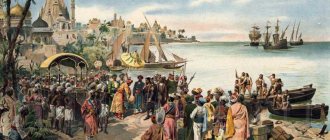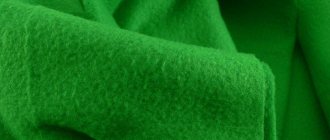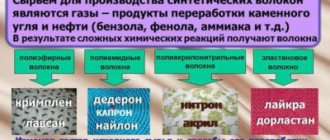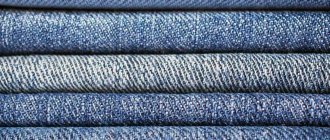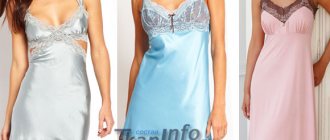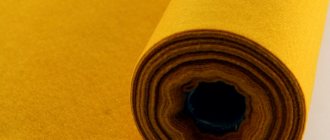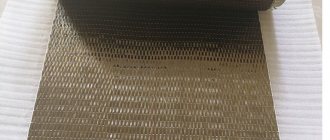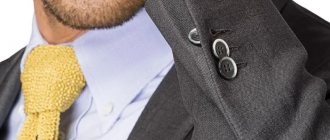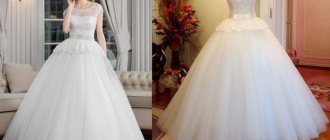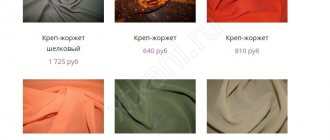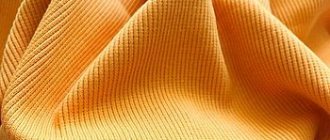Classification by composition
How a new product will look and its quality are determined by the structure of the fabric, namely the composition of the fibers. Natural, synthetic and mixed fabrics for clothing are used as raw materials for creating models. Each type has its own classification of fabrics.
In the first case, the products are of plant and animal origin. In the second option, the fabric is obtained by processing oil and coal. Finally, mixed fibers are a combination of several groups of fibers. In the production of clothing, a combination of types of fabrics is carried out in order to find the best solution and obtain a new type of product that will have all the positive qualities of all types of materials at once. In order to correctly select fabrics for sewing a fashion model, their characteristics, positive and negative aspects must be taken into account.
Natural
They represent the most valuable material. Natural fabric does not irritate a person’s skin, allows him to breathe, and does not cause diseases. Due to their safety, such fabrics are used to produce clothes for newborns and small children, bedding and underwear.
In clothes made from natural fabrics there is no place for synthetic and other artificial additives. The product is environmentally friendly and has positive properties. There are main groups of natural fabrics:
- Silk - light, durable and elastic materials (silk, dupont, satin, crepe);
- Cotton - soft, environmentally friendly, wear-resistant, easily combined with other groups of fabrics (velor, corduroy, denim, satin, jacquard);
- Wool - during production, animal wool is taken: sheep, goat, camel. The result is felt, cashmere, batting, drape, felt;
- Linen - have good thermal conductivity and wear resistance (linen, burlap, fine linen).
In the production of natural fabrics for clothing, chemical and synthetic components are not used, so the products are highly environmentally friendly and suitable for people suffering from skin and respiratory diseases.
Silk
Cotton
Woolen
Linen
Synthetic
Such fabrics are produced chemically, the raw materials for which are oil, gas and coal. Synthetic materials are suitable for sewing protective clothing, which is used in emergency situations, as well as for creating sports uniforms. Compared to natural fabrics, synthetics have their pros and cons.
Advantages of synthetic products:
- Long service life. Artificial materials have improved wear resistance; they are not exposed to harmful bacteria, mold and mildew. High-tech processing of fibers during the production process with subsequent dyeing of the fabric provides it with a durable color for a long operational period;
- Light weight material. Synthetic clothing is lightweight, water-repellent and dries instantly. Due to high demand from buyers and the low cost of raw materials, clothing production volumes are increasing, reducing the final cost of the product.
The disadvantages of synthetics include:
- May negatively affect human health – people suffering from skin diseases may experience allergies;
- The material is highly electrified;
- Poorly absorbs moisture and allows air to pass through, reducing the hygienic characteristics of the fabric.
Recently, types of clothing with a metallic sheen have become popular in the fashion world. The effect is achieved by applying a film of real metal or alloy to the surface of the product using a high-tech method. Previously, metallized fabric was used as reflective coatings for uniforms.
Mixed
Mixed products are a combination of natural and synthetic components in different proportions. The result is a strong, reliable and comfortable fabric. Clothes made from mixed materials do not wrinkle, retain their shape, do not fade and are pleasant to the touch. The surface of the fabric is sometimes coated with water-repellent impregnation.
Combined fabric is widely used in the creation of industrial designs of work suits. It is noteworthy that ready-made clothing patterns are also stitched with threads that contain natural and synthetic fibers.
The method for producing blended fabric is to mix dissimilar fibers at the initial spinning stage. The finished canvas looks the same on both sides.
The largest manufacturer of women's, men's and children's clothing made from mixed fabrics in the post-Soviet space is the Tekhnotkan brand, Kyrgyzstan. The clothing samples are made with high quality and style; the models feature expensive fittings, guipure and leather inserts.
Characteristics of the main types of fabrics
Cotton fabrics are highly hygienic, wash and iron well, are quite durable and beautiful. These fabrics are very diverse in thickness and appearance - from thin and delicate fabrics, such as voile, cambric, to dense and durable - denim, tarpaulin. They are produced both from pure cotton and mixed with other natural and artificial fibers.
Linen fabrics are a little rougher in appearance than cotton fabrics. Very hygienic, durable, wear-resistant, easy to wash and iron. Fabrics made from pure linen wrinkle heavily, but with the addition of chemical fibers they become elastic and wrinkle-resistant. Fabrics made from high-quality flax varieties have a soft silky shine, are flexible and elastic, and are used for the manufacture of women's and children's clothing, table linen and bed linen.
Silk fabrics (natural) have good hygienic properties, sufficient strength, and wear resistance. They have a beautiful shine, which manifests itself to varying degrees, depending on the nature of the thread twist and the method of weaving - from matte, delicate on transparent crepe chiffon, to dense, deep on satin and crepe satin. Silk fabrics are delicate, light, flexible, and drape beautifully. They wash well and iron well. Crepe fabrics wrinkle slightly, but have a high “deceptive” shrinkage, which disappears when ironed wet.
Woolen fabrics also have good hygienic properties and retain heat well, which is used for making outerwear. Woolen fabrics have a very rich assortment. From thin and translucent crepe fabrics for elegant women's clothing, to thick, voluminous coat fabrics such as drape and tweed. They have good ductility, elasticity, and strength. Pure wool fabrics have the disadvantage of felting, which after washing worsens the appearance and leads to significant shrinkage.
Acetate fabrics are light, shiny silks with a smooth iridescent surface. Their disadvantages include unsatisfactory hygienic properties, wrinkleability and low strength, especially when wet. After washing, ironing while wet is required, otherwise the fabric will not smooth out well.
Polyamide fabrics have a silky surface, high strength and shape stability, and a beautiful appearance. They are produced in a wide range - from elegant dress fabrics to coat and special fabrics. These fabrics are non-hygroscopic, easy to wash, have water- and dirt-repellent properties and are wrinkle-resistant. The disadvantage of these fabrics is the loss of strength and color from prolonged exposure to sunlight. You can iron clothes made from such fabrics only with a low-heat iron, since they melt when the temperature rises. These fabrics are widely used for the manufacture of off-season and special clothing.
Blended fabrics are made from threads containing various fibers. The range of such fabrics is varied: these include suit and dress fabrics, which in appearance resemble wool and linen, and cotton, and various raincoat fabrics with surface imitation from cotton to silk and wool. Fabrics have varying degrees of hygiene, but, as a rule, they are all wrinkle-resistant, wash and iron well, retain their shape and have sufficient strength.
Knitted fabric is a knitted fabric (or product) made from one or more threads. Knitwear is produced by interweaving threads to form loops on various types of knitting machines. In knitting production, almost all types of threads and yarns produced for textile production are used. When making products from knitted fabric, it is necessary to take into account some of its features. Thus, knitwear is much more stretchable than fabric, and it stretches in almost all directions (while fabric stretches well only at an angle of 45°). This feature should be taken into account when determining the size of the fit allowance.
Many types of knitted fabric practically do not fray, which makes it possible not to overcast the internal sections of the product parts. But when cutting through the threads of knitwear products, the chain of loops may unravel, which greatly spoils the product. Therefore, when working with such fabric, you need to select needles and threads very carefully and perform machine stitches at low speed.
Due to the high stretchability of knitwear, when sewing parts, the seams should be slightly stretched (so that the seam threads do not break during use) or sewn down with a zigzag stitch. To sew sections of modern knitted fabrics, you can only use a four-thread overlocker. See Which overlocker to buy.
In the main seams of the product that carry a large load (shoulder seams, sleeve seams, seams connecting the bodice with the skirt), it is necessary to lay reinforcing braid or narrow strips of fabric. Knitted fabrics hardly wrinkle, but they require less ironing, so carefully select the heating mode of the iron; knitwear containing synthetic fibers cannot withstand high temperatures. Before cutting, synthetic fabric should be ironed well so that it shrinks before the product is sewn.
Types depending on the type of clothing
Modern brands specializing in the production of fashionable clothing present such a huge number of fabrics that it is difficult to stop and choose a specific item. The comfort and convenience of clothing is ensured by the material from which the product is made. For example, for home clothes, a flannel jacket and flannel are more appropriate. In hot weather, it is convenient to wear light clothes made of thin knitwear or chintz. For outerwear in cool weather, you should choose warm drape or rateen. In spring or autumn during the rainy season, the best companion would be a raincoat or waterproof fabric. There are a large number of names of fabrics, and in order to know whether a fabric is suitable, you need to be guided by its characteristics.
Upper
As soon as the first signs of cold weather arrive, the wardrobe begins to be replenished with jackets, down jackets and raincoats. Cashmere, cloth, wool, suede, leather and drape are used to create warm jackets and coats. Raincoats, denim and nylon are an integral part of windbreakers. Fur coats are a rich combination of leather and natural or artificial fur.
The main list of names of fabrics used in sewing outerwear:
- Cashmere is a lightweight, warm fabric made from pure wool, made by a special method of weaving fibers - practical and comfortable;
- Gabardine is a wear-resistant woolen fabric;
- Suede – has a waterproof velvet surface. This is a thin, soft and pleasant to the touch type of leather;
- Eco-leather is a durable material on a cotton basis, the pattern on the surface is made by embossing and resembles natural leather;
- Nylon is a synthetic material that has high strength and resistance to deformation;
- Corduroy – a cotton base with a velvety ribbed texture;
- Velor is a soft and dense material, depending on the quality of the fibers that predominate in the fabrics, it can be cotton, wool and synthetic;
- Drape – woolen fabric with a smooth surface;
- Cloth is a material made of wool with a pile coating, does not get wet and protects in windy weather;
- Quilted fabric - two types of fabrics, stitched together, and inside there is insulation in the form of cotton wool, silicone, padding polyester or batting. The name quilted fabric comes from old England, where the patchwork technique used to flourish;
- Jeans - cotton yarn with the addition of lycra provides durability and versatility of the models. Denim items fit almost any type of wardrobe;
- Raincoat - the basis of the fabric is made up of mixed fibers of cotton fabric, suitable for use in any weather;
- Jacquard fabrics are fabrics in which natural and artificial fibers are intertwined in such a way that a relief pattern is obtained. Clothing made from jacquard is capricious and requires increased attention;
- Faux suede is soft and comfortable, microfiber fabric has increased strength.
Suede
Cashmere
Drape
Velveteen
Raincoat
Quilted
Jeans
Summer
In hot summer weather, you will need light, comfortable clothing that can protect you from overheating and will not hamper your movement. The material should absorb moisture, dry quickly and ventilate the air. Clothes will have to be washed a lot, so the fabric needs to be selected so that after several rinses, it will not lose color.
What fibers are summer fabric made from?
- Hemp uses the stem of the plant, which is processed and converted into thread. It has a durable structure, does not accumulate static electricity, does not wrinkle;
- Flax is an environmentally friendly product. The resulting fabric is not electrified and allows air to pass through well;
- Chinese nettle (Ramy) – the fibers are soft, breathable, and do not rot;
- Cotton – absorbs moisture, wrinkles, takes a long time to dry, and is the most suitable material for hot summers;
- Silk – has a long service life, does not lose shape, the fibers are strong and shiny;
- Wool is a warm material obtained from the hair of domestic animals. For summer collections, the finest fiber is used;
- Lightweight denim clothing is suitable for creating summer collections for women and men.
When sewing light items with large patterns, you should avoid adding small details to the look. This combination will only spoil the beauty of expensive material.
Rami
Cotton
Hemp
Demi-season
This type of clothing is considered the most important in the wardrobe of people who live in places with a variable climate and a long autumn-spring period. The demi-season fabric option is knitted fabric. It is comfortable to wear, pleasant and soft to the touch. The material will protect from strong cold winds and unpleasant dampness. It is convenient to use in winter too.
Types and brief description of fabrics:
- Pile - has a short pile on the front side, consisting of vertical threads. The advantage of a pile covering is its ability to retain heat on the harshest winter days. The structure of the fabric is strong and durable. Widely used in both casual wear and festive attire;
- Double-sided – looks the same on both sides (wool, drape, cashmere). If the fabric is frayed in some place, it can be re-faced. The price of the fabric is significantly higher than other types, but it retains heat well and is impenetrable to wind;
- Textile – the fibers of the fabric are arranged perpendicularly, forming a strong but not dense structure, and therefore provides little protection from the wind. Without lining, things will be cold and uncomfortable.
When choosing demi-season fabric, you need to pay attention to soft and water-repellent options. The canvas should not be too thick and dense.
Textile
Pile
Double sided
Sports
To achieve excellent results in sports, the athlete's form plays a special role. It should be comfortable and comfortable with strong seams. Sportswear should not restrict the athlete’s movements during exercise, not retain moisture, and be elastic.
The most popular material for sportswear from the list of natural fabrics is cotton, which perfectly absorbs the athlete’s sweat, ensuring an unhindered supply of oxygen to the skin, without causing irritation to the skin. The disadvantage of the material is considered to be low elasticity, so elastane is included in the composition of cotton fabric, which allows the clothes to fit the athlete’s figure. Natural fabrics alone cannot be used in sports, and to improve the wear resistance of clothing, synthetic material, primarily polyester, is added. There are other materials:
- Diving is a mixed fabric with elements of viscose, elastane and polyester. Effectively removes moisture, dries instantly and can be used in other types of clothing;
- Taffeta - used as a lining for outerwear, as well as a cover for sports equipment;
- Duspo - no sports suit can be made without it. The material has a velvety appearance and is additionally treated with polyurethane impregnation;
- Dazel is a knitted fabric designed to create sports options for intensive physical education;
- Mesh is the same knitwear, only there are pores in the structure of the material. Widely used in sportswear and travel clothing as a lining.
Fabrics used to create sportswear models must meet the following requirements:
- Long service life;
- Hygiene;
- Elasticity;
- Air permeability;
- Providing comfort.
Knitted sportswear can consist of natural and synthetic fibers. The fabric is widely used when sewing leggings and leggings that fit the human figure. The positive or negative aspects of any matter directly depend on its structure and properties.
The main advantages of sportswear fabrics:
- Provides moisture passage through itself and dries quickly;
- Retains its shape when worn and after washing;
- Long term of continuous operation;
- Does not form snags;
- Does not require scrupulous care.
When creating sports models, a special mesh is used, which forms an air gap and provides ventilation. Polyester combined with cotton is ideal for sewing sportswear. The surface of such products repels water and dirt, things retain their original appearance for a long time and do not shrink when washed.
Diving
Duspo
Net
Taffeta
Tourist
For long trips and hikes, you need wear-resistant, comfortable and functional clothing. The fabric should not only wick away moisture, but also block ultraviolet rays from the sun. Cotton and polypropylene are what you need. The combination of the two materials is convenient for use in arid areas and deserts. The fact is that cotton quickly absorbs moisture, and once wet, after a while it will begin to cool, losing almost all of its insulating abilities. This is where cotton begins to intensively absorb heat, so it is not recommended to use a cotton product in winter. And in the hot desert, this is the best choice.
Polypropylene, unlike cotton, does not absorb, but rather allows moisture and sweat to pass through and dries instantly. This material is used as the main layer when sewing tourist clothing. It is easy to wear, soft, and inexpensive. There are several disadvantages of the material:
- Formation of an unpleasant odor when worn continuously;
- It is not recommended for use in high ambient temperatures, such as near an open fire. Propylene is a man-made synthetic material and can melt under extreme heat.
Polyester is the next material used when sewing variants of tourist clothing. What is polyester? The material is a synthetic product that can absorb large amounts of moisture. Fabric fibers are excellent heat insulators; they are woven into other fabrics and ensure the product’s resistance to stress. The fabric comes in a variety of vibrant colors, making the tracksuit more visible.
Polypropylene
Cotton
Polyester
Children's
This type of clothing requires special attention when creating it. The products are based on natural fabrics that are light, elastic and safe. The following are in particular demand:
- Chintz is a type of cotton. This material is used to make sets for newborns and small children, as well as bedding and underwear;
- Baptiste is a leader in the creation of dresses, translucent blouses and bedding;
- Flannel - products for babies cannot do without it: rompers, vests and diapers;
- Fleece is an indispensable material for baby diapers.
Recently, when sewing children's clothing, they began to use neoprene - an artificial material that has a high degree of resistance to mechanical and chemical influences. It is waterproof, repels dust and dirt, wears well and keeps its shape.
Knitted fabric is another representative involved in the creation of children's clothing. It is endowed with increased thermal insulation properties, does not shrink and allows the child to move freely, which is important.
There are a large number of fabrics for children's clothing - footer, interlock, pekhorka and many others. Which of this variety of fabrics is better cannot be answered unequivocally. The determination of the source material in the creation of children's clothing fabrics depends on the purpose of the child's clothing, taking into account many factors.
Chintz
Bike
Flannel
Batiste
The meaning of the word "fabric"
textile
1. text. woven fabric, material ◆ I also wanted to decorate my toes with sparkling rings and thread sparkling earrings into my nostrils and ears, and silk fabric
wrap tightly around my waist, but I was content with a piece of white coarse
cloth
to cover myself from greedy, sinful glances.
Doroshevich, “The Dream of a Hindu,” 1897 ◆ Without answering, he threw back the fabric
that hid his face and chest, and the powerful muscles under the dark bronze skin of an Arab born in Africa were revealed to the old woman.
N. S. Gumilyov, “Princess Zara” ◆ At the end of the 19th century in Central Europe, due to a shortage of cotton, interest in fabrics
made from nettle fiber arose again. Alexander Volkov, “Dressing like a needle and without a thread”, 2003 // “Knowledge is power” (quote from NKR)
2. transfer a material woven from fibers in some way ◆ A new bitumen binder is applied to BB-K fiberglass (non-woven material made from intersecting staple glass fibers bonded with synthetic resins, also recently created at the All-Union Glass Fiber Research Institute); produces a durable, elastic fabric
", easily rolled into a roll - this is glass roofing felt. “News from everywhere,” 1969 // “Chemistry and Life” (quote from NKR)
3. transfer structure, nature of a work of art, text, etc. ◆ The novel has neither a beginning, nor a denouement, nor a strictly thought-out plan; there are types and characters, there are scenes and pictures, and, most importantly, through the fabric
The story reveals the author’s personal, deeply felt attitude towards the identified phenomena of life.
Pisarev, “Bazarov”, 1862 ◆ Peering into the fabric
of his own and every other life, looking now into the newly begun life of Vera, he saw more clearly this game of artificial accidents, some kind of will-o’-the-wisp of evil deceptions, blindnesses, pre-arranged abysses , with blunders, mistakes, and a number of them - also like random outcomes from tangled knots... Goncharov, “Breakage”, 1869
4. transfer poet. the same as the veil ◆ With the same melancholy, with the usual excitement, // I swear to pay you a grateful tribute; // Always greet you with a heartfelt thought, // O firstborn of winter, brilliant and gloomy! // First snow, our fields on virgin tissue
! Vyazemsky, “First Snow”, 1819
5. transfer high plexus, interweaving of something ◆ Just like a minute ago, hanging over your head, living tissue
greenery; birds fluttered; The ripe large fruits, studded with thorns, were turning yellow. Green, "Renaud Island", 1909
6. biol. honey. building material of a living organism, an anatomical structure consisting of relatively homogeneous cells ◆ A organic tissue
, if it is viable, it must respond to any irritation.
And I react! I respond to pain with screams and tears, to meanness with indignation, to abomination with disgust. Chekhov, “Ward No. 6”, 1892 ◆ Skin tissue
consists of collagen protein fibers, tightly intertwined.
D. Osokina, “The game is worth the candle” // “Chemistry and Life” (quote from NKR) ◆ Although adipose tissue
is located even further from the surface of the skin than the dermis, it is no less important from an aesthetic point of view. A. Margolina, “Skin through the prism of cosmetology”, 2007 // “Science and Life” (quote from NKR)
Phraseologisms and stable combinations
- rough fabric
adipose tissue
Rating of the best
All fabrics are good in their own way, each is endowed with advantages that others do not have. In the fashion world, three types of best fabrics for clothing have been identified, which are worthy leaders among the rest:
- First on the list is cashmere, a delicate and presentable material widely used in the creation of outerwear models. The advantages of the material are strength and thermal insulation properties;
- Next on the list is woolen fabric - tweed. Inferior to cashmere in appearance, it does not seem too rich and expensive;
- Raincoat firmly occupies the third stage - the appearance is quite simple, but the protective properties are excellent. She is not afraid of adverse weather conditions: wind, rain, dirt. And she is not afraid of the cold if she has good insulation.
Each buyer has the right to choose the material himself and put it in a leading position. Whether it will be clothes made from natural fabrics or unusual items made from synthetics - it all depends on the person’s taste and predisposition to the way he or she dresses. It is difficult to remember all the names of fabrics for clothing production, but their characteristics can be easily found in the catalogs of specialized online stores.
